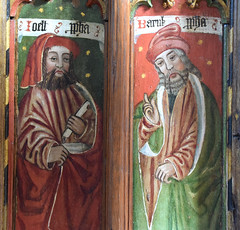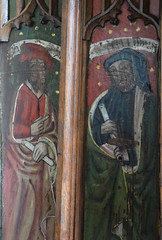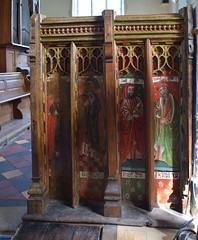| |
|
 |
|
I've now been
visiting this remote little church for twenty
years. I love to cycle around the back lanes of
Suffolk as summer becomes autumn, the land
quietly putting itself to bed for the winter,
woodsmoke in the air, the edgy cries of pheasants
in the woods, the light whitening out as the
afternoon lengthens. When I first came to St Nicholas, it
was in early October 1998. They were getting
their church ready for the harvest festival, one
of those very English events which must seem
curious to a foreign visitor. Harvest festivals
are one of those peculiarly Anglican inventions.
Like many such ancient traditions, they actually
only date back to the 1840s or so. Most Suffolk
village churches have them, and do them very
well. For some churches, it seems the only time
apart from Christmas that the building comes
alive.
On this occasion, half a dozen people were busy
arranging apples, and marrows, and pumpkins, and
leeks, piled in crates and carrier bags at the
entrance to the church. They chatted as they did
so, and it struck me that this was a kind of
communion, the parish being together and talking
to itself.
|
There is a
particular smell to a medieval church filled with fruit
and vegetables. Once experienced, it is never forgotten,
and instantly draws your imagination back to ancient
walls, soft wood and cool tiles. For me, it still recalls
the beautiful late medieval roodscreen at Bedfield, lined
with apples and onions.
I had cycled
here along the track from Tannington. Once this leaves
the farmyard behind, it becomes the kind of track you'd
have found all over Suffolk before the 1920s and 1930s.
When you look at an old road map of Suffolk, you find
many more byways marked than there are today. Some of
them were surfaced, many have disappeared completely. The
track between Tannington and Bedfield seems to be still
deciding whether or not to settle on the latter option,
for at several points it becomes nothing more than
overgrown tractor ruts in the mud. But for most of the
way it is a gravel track which for part of its route
winds pleasantly through woodland.
Once, in the last year of the 20th Century, I passed a
real gipsy caravan on this track. It was late winter, and
the cold afternoon light was fading. The brightly
coloured caravan had come to a halt, the little horse
pulling miserably at the coarse tussocks on the field
side. Behind, a man was working at a makeshift forge, the
coals flaring suddenly in the uncertain dusk. He nodded
once as I passed. I still don't know if it was real.
I came back later in the year on the occasion of the
Historic Churches bike ride, and Bedfield church was
bathed in the honeyed warmth of late summer. A giant
puffball grew by the churchyard gate, and would have made
a fine meal if the rats hadn't got to it first. Again the
church was busy, a smiling lady at a table signing the
forms of a couple of teenage girls with their dad. On
this occasion, I could see the roodscreen without having
to negotiate fruit and vegetables.
Unusually,
the panels contain eight Old Testament prophets in
gorgeous reds and greens. The faces of some of the
prophets have been viciously attacked with a knife. This
may have been the work of mid-16th century reformers, but
it appears as though the same thing done at Brundish, a
couple of miles off, was actually work commissioned by
the iconoclast William Dowsing on behalf of the puritans
a century later. Dowsing never came to Bedfield, though,
but perhaps the Brundish churchwardens did. We stood
together, the smiling lady and me, imagining the past.
Why even do
it? It may simply have been a result of the injunction
against images, that fundamentalist mistrust of the
beauty of the human face being depicted. We have had a
reminder with the evils meted out by the Islamic State in
Syria and Iraq that fundamentalism never did anybody any
good, and the terrors of the Cromwellian night extended
far beyond destroying artwork. As Erich Maria Remarque
observed, tolerance is the daughter of doubt. So it gives
me immense pleasure to see that behind the wicked knife
slashes, the prophets seem a jolly lot, with smiles on
their faces and the attitudes of old friends having a
good time. Perhaps that is why they were attacked.
   
St Nicholas
sits on the edge of another farmyard, although a proper
road connects it to the fine pub and the village beyond.
The tower dates from the 14th century, when the entire
church seems to have been rebuilt, although there's quite
a lot of evidence of the earlier church, including a fine
Norman north doorway. There are three niches on the west
face of the tower. From their relationship with each
other, we can deduce that they probably contained a rood
group. Peter and I came this way in June 2007, as part of
my plan to revisit the 650-odd Suffolk churches I had
explored more than six years earlier. Quite honestly, we
didn't expect to get in, because what I haven't mentioned
was that, in those days, Bedfield church was just about
the only medieval church in this part of Suffolk which
was kept locked without a keyholder. However, as with
several other places in the area on this beautiful day,
St Nicholas was undergoing its spring clean. The grass
was being cut, the benches polished, the floors mopped.
In fact, they were just finishing, cars pulling off. As
we walked up the graveyard path, we met the keyholder
coming the other way. She was very kind, and very
helpful. She went and checked with her husband that it
would be okay for us to see inside, and then let us into
the Priest door, and we stepped inside to the trim
interior.
The church is smaller than it looks from outside. There
was a major restoration in 1870, which left St Nicholas
looking the very model of a rural parish church. The
brick floor is an organic setting for some lovely rustic
woodwork. It seems that the village had an enthusiastic
carpenter in the late 17th century, for the group of
benches by the door, the font cover and the pulpit all
date from this time The benches are haunting, and it
doesn't take much to imagine our ancestors tight-packed
on them, shuffling their bottoms awkwardly at the
preaching of the Word. I assume that most churches once
had benches like this, and that they were destroyed at
the time of 19th century restorations. The font cover is
intricate, and it opens up without the need to remove it,
as at Bramford and Boxford.
This was all well and good, but something was nagging me
as we poked around. And then I was startled to notice
that the rood screen had gone. Now, this isn't the kind
of thing you usually expect. Surely it couldn't have been
stolen? Fortunately not, for I was told it had been
removed to be cleaned by the artist Christine Easton, who
lives in the village, and would shortly be returned.
When it came
back, so did I. I had also been told that Bedfield church
was now open every day, so with some enthusiasm I cycled
down the track from Tannington again, which twenty years
on is now near impassable in places, necessitating
getting off my bike and lifting it over rubble.
Ahead of me, St Nicholas was beautiful in the early
autumn sunshine, a diadem at the end of the long track. I
stepped inside to its instantly familiar homeliness and
small-scale elegance, to the sight of the old screen as
if it had never been away. Beyond the screen, the
sanctuary was a riot of tiles and gothic lettering.
vibrant in the light. Decoration of this type was deeply
unfashionable for most of the twentieth century, and it
did well to survive.
A poignant ledger stone to Thomas Dunston bears a simple
skull and the inscription Hodie Mihi, Cras Tibi
('Mine today, yours tomorrow'). It is dated December 25th
1657, which is Christmas Day for us, but not for Thomas
Dunston, for this was during Oliver Cromwell's
Commonwealth, and the celebration of Christmas, like so
much else, was illegal. Hard to imagine, now, perhaps,
although intolerance survives like a virus in abeyance,
and always needs to be guarded against.
Simon
Knott, September 2018
|
|
|

